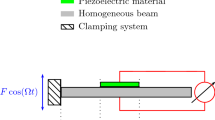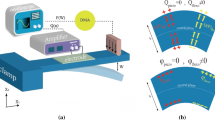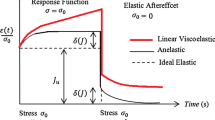Abstract
In this paper, a spectrally formulated finite element in frequency domain for an electrostrictive material embedded in a composite beam is derived. The presence of quadratic non linearity of the electric field in the constitutive equation poses some challenge in the formulation of the model and we use convolution in the frequency domain. The formulation is carried out using Hamilton’s theorem and this is subsequently applied to a bimorph beam which has electrostrictive wafer mounted on the top as well as bottom surfaces of the beam. The bimorph beam is chosen so that we can control the beam by applying different and independent electric potentials for the top and bottom surfaces of the beam. The non linearity in the constitutive model results in the generation of additional nonlinear waves. The formulated spectral element elegantly captures these nonlinear waves. The efficiency of electrostrictive actuator for both single and multi modal open loop control is studied in detail. This aspect is demonstrated through a number of numerical examples. The studies also show that the control efficiency in electrostrictive actuator is limited by the amplitude of the electric field. When the electric field is beyond a certain level, it can be seen that although the amplitude of the primary wave decreases, non-linearity in the model causes sign reversal and splitting of incident and reflected waves. It can also be seen that the amplitude of nonlinear wave tend to increase with increase in applied electric field. The paper initially investigates the use of electrostrictive material as an actuator and this idea is gradually expanded to the use of electrostrictive material as a sensor. Various numerical experiments are carried out to demonstrate this aspect and its applications in the detection of the crack. It can be seen that the spectral element derived elegantly captures the location and size of the crack.


























Similar content being viewed by others
References
Blackwood GH, Ealey MA (1993) Electrostrictive behavior in lead magnesium niobate (PMN) actuators. Part I: materials perspective. Smart Mater Struct 2:124–133
Cardano G (1545) Artis Magnæ, Sive de Regulis Algebraicis Liber Unus
Chakraborthy A, Gopalakrishnan S (2003) A spectrally formulated finite element for wave propagation in functionally graded beams. Int J Solids Struct 40:2421–2448
Fripp MLR, Hagood NW (1997) Distributed structural actuation with electrostrictors. J Sound Vib 203(1):11–40
Furukawa T, Seo N (1990) Jpn J Appl Phys Part 2 29:675
Ge L, Wang X, Wang F (2014) Accurate modeling of PZT-induced Lamb wave propagation in structures by using a novel spectral finite element method. Smart Mater Struct 23(9):095018
Gopalakrishnan S, Martin M, Doyle JF (1992) A matrix methodology for spectral analysis of wave propagation in multiple connected Timoshenko beams. J Sound Vib 158:11–24
Hom CL (1999) Simulating electrostrictive deformable mirrors: II. Nonlinear dynamic analysis. Smart Mater Struct 8:700–708
Hom CL, Dean PD, Winzer SR (1999) Simulating electrostrictive deformable mirrors: I. Nonlinear static analysis. Smart Mater Struct 8:691–699
Hom CL, Pilgrim SM, Shankar N, Bridger K, Massuda M, Winzer SR (1994) Calculation of quasi-static electromechanical coupling coefficients for electrostrictive ceramic materials. IEEE Trans Ultrason Ferroelectr Freq Control 41:541–551
Hom CL, Shankar N (1998) A dynamics model for nonlinear electrostrictive actuators. Trans Ultrason Ferroelectr Freq Control 45(2):409–420
Hwang WS, Park HC (1993) Finite element modeling of piezoelectric sensors and actuators. AIAA J 31:930–937
Landau LD, Lifshitz EM (1960) Electrodynamics of continuous media. Pergamon Press, Oxford
Nye JF (1985) Physical properties of crystals. Oxford University Press, New York
Pablo F, Petitjean B (2000) Characterization of 0.9PMN-0.1PT patches for active vibration control of plate host structures. J Intell Mater Syst Struct 11:857–867
Roy Mahapatra D, Gopalakrishnan S (2003) A spectral finite element for the analysis of wave propagation in uniform composite tubes. J Sound Vib 268:429–463
Roy Mahapatra D, Gopalakrishnan S, Shankar TS (2000) Spectral-element -based solutions for wave propagation analysis of multiply connected unsymmetric laminated composite beams. J Sound Vib 237(5):819–836
Roy Mahapatra DR (2004) Spectral element models for wave propagation analysis, Structural health monitoring and Active control of waves in composite structures. Ph.D. Thesis, Indian Institute of Science, Bangalore, India
Uchino K (1986) Electrostrictive actuators:materials and applications. Ceram Bull 65:647–652
Uchino K (2000) Ferroelectric devices. Marcel Dekker, New York
Vardan VK, Vinoy KJ, Gopalakrishnan S (2006) Smart material systems and MEMS: design and development methodologies. Wiley, Hoboken, pp 119–128
Wadley HNG (1996) AGARD SMP lecture series on “Smart structures and materials: implications for military aircraft of new generation” USA
Xiao D, Han Q, Liu Y, Li C (2016) Guided wave propagation in an infinite functionally graded magneto-electro-elastic plate by the Chebyshev spectral element method. Compos Struct 153:704–711
Author information
Authors and Affiliations
Corresponding author
Rights and permissions
About this article
Cite this article
Kulkarni, R.B., Gopalakrishnan, S. Spectral element formulation for an electrostrictive material embedded in a beam. ISSS J Micro Smart Syst 6, 91–107 (2017). https://doi.org/10.1007/s41683-017-0010-2
Received:
Revised:
Accepted:
Published:
Issue Date:
DOI: https://doi.org/10.1007/s41683-017-0010-2




